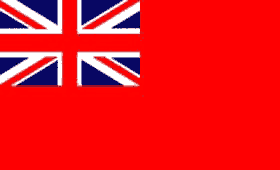The Battle of Trading Ford
February 3, 1781 at Trading Ford , Rowan County, North Carolina
(aka Island Ford)



|
|
| Strength |
Killed & Wounded
|
Missing / Captured |
| 150 |
2
|
? |
| |
| Strength |
Killed & Wounded
|
Missing / Captured |
| ? |
10-12
|
? |
| | Conclusion: British Victory |
|
Just as most of Greene’s forces and supplies made their way across the Yadkin at Trading Ford in the late hours of the day, Tarleton and Brig. Gen. Charles O’Hara with the Guards approached to find that the around 150 Patriots were laying in ambush, waiting for the British to enter. When the British Guards entered the site, the Patriots opened fire. There was brief skirmish between O’Hara’s column and 100 Virginia militia under Maj. David Campbell, as well as some North Carolina mounted militia led by Col. John Luttrell. After some heated shooting, the British made a bayonet charge towards the Patriots, who quickly withdrew from the river, abandoning some wagons carrying personal items. They finally made their escape at a crossing two miles down stream. O’Hara then returned to join the main army under Cornwallis which had reached Salisbury, where most of the army remained the next day resting. According to Joseph Graham, the Americans lost 2, and the British 10 to 12 killed and wounded.
Lossing: “General Greene had hoped, by guarding the fords on the Catawba with the light troops under Morgan, to prevent the passage of the British army until Huger and Williams should arrive with the other divisions of the American forces. The passage at Cowan’s Ford destroyed these hopes, and Morgan and his light troops retreated precipitately toward the Yadkin. The detachment of Lieutenant-colonel Webster crossed at Beattie’s Ford, and joined Cornwallis the next day [Feb. 2.], on the road to Salisbury, five miles from the crossing-place. The royal army rested at Salisbury 11 that night, and the next morning started in pursuit of Greene and Morgan. These officers did not await the dawn, but passed the Yadkin at Trading Ford while Cornwallis was slumbering; and when, on the morning of the third, the earl hastened to strike a fatal blow on the banks of that stream, the Americans were beyond his reach, and Providence had again placed an impassable barrier of water between them. Another copious rain in the mountains had swollen the Yadkin to a mighty river. The horses of Morgan had forded the stream at midnight, and the infantry passed over in bateaux at dawn. These vessels were secured on the east shore of the Yadkin, and Cornwallis was obliged to wait for the waters to subside before he could cross. Again he had the Americans almost within his grasp. A corps of riflemen were yet on the west side when O’Hara, with the van-guard, approached, but these escaped across the river, after a smart skirmish of a few minutes. Nothing was lost but a few wagons belonging to the Whigs who were fleeing with the American army, with their effects.
Tarleton: "General O'Hara having made a fruitless effort to get possession of the flats and large boats upon the river, took post with the infantry on the ground which commanded the ford and the ferry, and sent back the cavalry to Salisbury. A heavy rain swelled the Yadkin the succeeding day and night, and General Morgan remained on the eastern bank, facing the British troops."
Joseph Graham: “Before the rear came in [under Cornwallis], Brigadier-General O'Hara and the cavalry moved on. It was seven miles to the Trading Ford on the Yadkin, and it was getting dark when he came near. General Morgan had passed his regulars and baggage all over, and there remained on the south side only one hundred and fifty militia and the baggage wagons of the troops which had escaped from Cowan's Ford, and some others. Finding the British approaching, the militia were drawn up near a half mile from the ford, where a branch crosses which was covered with small timber and bushes, and there was an old field along the road in their front. When O'Hara came, twilight was nearly gone. The American position was low along the branch, under shade of the timber; that of the advancing foe was open and on higher ground, and between them and the sky, was quite visible. When they came within sixty steps, the Americans commenced firing, the enemy returned it and began to form a line. As their rear came up, they extended their line to the right, and were turning the left flank of the militia by crossing the branch above. This being discovered, a retreat was ordered after having fired, some two, some three rounds. It was easily effected in the dark. They passed down the river two miles and crossed over, abandoning the baggage and other wagons which could not be gotten over, to the enemy, after taking out the horses. Two of the militia were killed; the loss of the enemy was not known, but from appearances of blood in different places, believed to be ten or twelve. They were by far the most numerous, yet from the positions of the contending parties were most exposed. After the firing ceased, the British marched on to the river, but found the water was too deep to ford, and still rising, and that General Morgan, encamped on the other side, had with him all the boats and canoes. General O'Hara returned to Salisbury the same night, notwithstanding the badness of the roads. Those under his command marched thirty-four miles in the course of this day and part of the night. On the 4th, the army needed rest, and their commander being, it is supposed, undecided what course to pursue, they remained in Salisbury.”